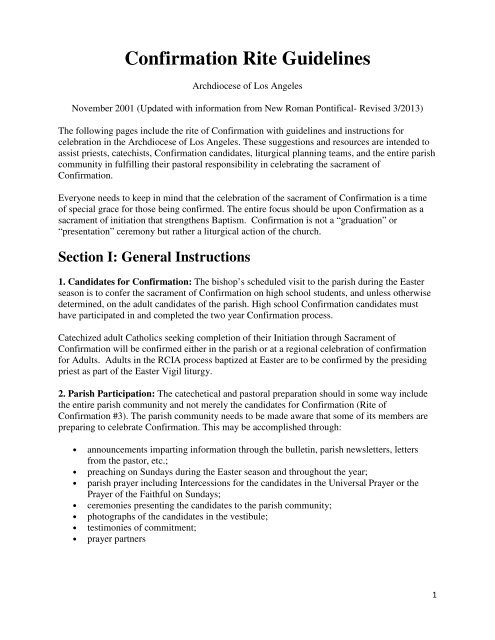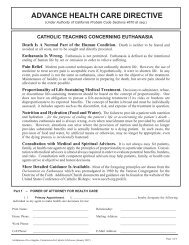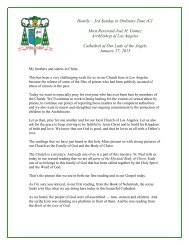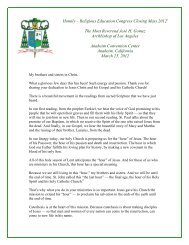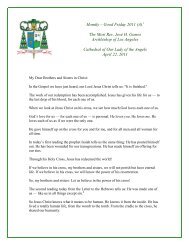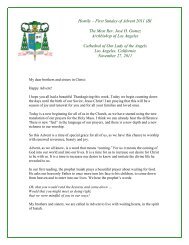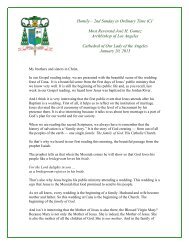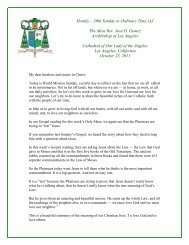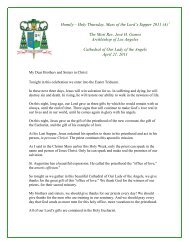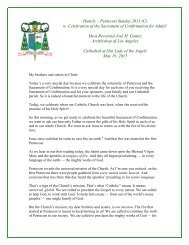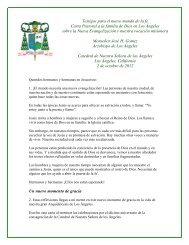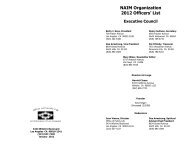Guidelines for the Rite of Confirmation (Revised 03-2013).pdf
Guidelines for the Rite of Confirmation (Revised 03-2013).pdf
Guidelines for the Rite of Confirmation (Revised 03-2013).pdf
Create successful ePaper yourself
Turn your PDF publications into a flip-book with our unique Google optimized e-Paper software.
<strong>Confirmation</strong> <strong>Rite</strong> <strong>Guidelines</strong><br />
Archdiocese <strong>of</strong> Los Angeles<br />
November 2001 (Updated with in<strong>for</strong>mation from New Roman Pontifical- <strong>Revised</strong> 3/<strong>2013</strong>)<br />
The following pages include <strong>the</strong> rite <strong>of</strong> <strong>Confirmation</strong> with guidelines and instructions <strong>for</strong><br />
celebration in <strong>the</strong> Archdiocese <strong>of</strong> Los Angeles. These suggestions and resources are intended to<br />
assist priests, catechists, <strong>Confirmation</strong> candidates, liturgical planning teams, and <strong>the</strong> entire parish<br />
community in fulfilling <strong>the</strong>ir pastoral responsibility in celebrating <strong>the</strong> sacrament <strong>of</strong><br />
<strong>Confirmation</strong>.<br />
Everyone needs to keep in mind that <strong>the</strong> celebration <strong>of</strong> <strong>the</strong> sacrament <strong>of</strong> <strong>Confirmation</strong> is a time<br />
<strong>of</strong> special grace <strong>for</strong> those being confirmed. The entire focus should be upon <strong>Confirmation</strong> as a<br />
sacrament <strong>of</strong> initiation that streng<strong>the</strong>ns Baptism. <strong>Confirmation</strong> is not a “graduation” or<br />
“presentation” ceremony but ra<strong>the</strong>r a liturgical action <strong>of</strong> <strong>the</strong> church.<br />
Section I: General Instructions<br />
1. Candidates <strong>for</strong> <strong>Confirmation</strong>: The bishop’s scheduled visit to <strong>the</strong> parish during <strong>the</strong> Easter<br />
season is to confer <strong>the</strong> sacrament <strong>of</strong> <strong>Confirmation</strong> on high school students, and unless o<strong>the</strong>rwise<br />
determined, on <strong>the</strong> adult candidates <strong>of</strong> <strong>the</strong> parish. High school <strong>Confirmation</strong> candidates must<br />
have participated in and completed <strong>the</strong> two year <strong>Confirmation</strong> process.<br />
Catechized adult Catholics seeking completion <strong>of</strong> <strong>the</strong>ir Initiation through Sacrament <strong>of</strong><br />
<strong>Confirmation</strong> will be confirmed ei<strong>the</strong>r in <strong>the</strong> parish or at a regional celebration <strong>of</strong> confirmation<br />
<strong>for</strong> Adults. Adults in <strong>the</strong> RCIA process baptized at Easter are to be confirmed by <strong>the</strong> presiding<br />
priest as part <strong>of</strong> <strong>the</strong> Easter Vigil liturgy.<br />
2. Parish Participation: The catechetical and pastoral preparation should in some way include<br />
<strong>the</strong> entire parish community and not merely <strong>the</strong> candidates <strong>for</strong> <strong>Confirmation</strong> (<strong>Rite</strong> <strong>of</strong><br />
<strong>Confirmation</strong> #3). The parish community needs to be made aware that some <strong>of</strong> its members are<br />
preparing to celebrate <strong>Confirmation</strong>. This may be accomplished through:<br />
• announcements imparting in<strong>for</strong>mation through <strong>the</strong> bulletin, parish newsletters, letters<br />
from <strong>the</strong> pastor, etc.;<br />
• preaching on Sundays during <strong>the</strong> Easter season and throughout <strong>the</strong> year;<br />
• parish prayer including Intercessions <strong>for</strong> <strong>the</strong> candidates in <strong>the</strong> Universal Prayer or <strong>the</strong><br />
Prayer <strong>of</strong> <strong>the</strong> Faithful on Sundays;<br />
• ceremonies presenting <strong>the</strong> candidates to <strong>the</strong> parish community;<br />
• photographs <strong>of</strong> <strong>the</strong> candidates in <strong>the</strong> vestibule;<br />
• testimonies <strong>of</strong> commitment;<br />
• prayer partners<br />
1
3. Sponsors: A Baptismal godparent is not only allowed, but is in fact desired as <strong>the</strong><br />
<strong>Confirmation</strong> sponsor, in order to emphasize <strong>the</strong> relationship between Baptism and <strong>Confirmation</strong><br />
(Canon 893.2).<br />
"Pastors will see that <strong>the</strong> sponsor is spiritually qualified <strong>for</strong> <strong>the</strong> <strong>of</strong>fice" (RC, #6). The sponsor <strong>for</strong><br />
any candidate may be male or female, is to be sufficiently mature, (at least 16 years <strong>of</strong> age), a<br />
fully initiated Catholic and living a life <strong>of</strong> faith which befits <strong>the</strong> role to be undertaken, and is not<br />
prohibited by Canon Law from exercising <strong>the</strong> role <strong>of</strong> sponsor. A parent may not act as a sponsor<br />
<strong>for</strong> his or her child (Canon 874).<br />
Individuals selected as sponsors must be Catholics who are able to receive <strong>the</strong> Sacraments <strong>of</strong> <strong>the</strong><br />
Church. Sponsors are expected to receive Holy Communion at <strong>the</strong> Mass <strong>of</strong> <strong>Confirmation</strong>.<br />
4. Names: The use <strong>of</strong> <strong>the</strong> baptismal name on <strong>the</strong> occasion <strong>of</strong> <strong>Confirmation</strong> better expresses <strong>the</strong><br />
relationship between Baptism and <strong>Confirmation</strong>. If a special <strong>Confirmation</strong> name is taken, it must<br />
be <strong>the</strong> name <strong>of</strong> a recognized saint (such as St. John, St. Martha, St. Teresa, Blessed Junipero<br />
Serra) or an acceptable recognized Christian name (such as Faith, Charity, Prudence). Individual<br />
teachers must guide <strong>the</strong>ir students in <strong>the</strong> selection <strong>of</strong> a <strong>Confirmation</strong> name, and those names are<br />
to be approved in advance. Only full names are to be used, e.g., “Joseph, Robert, Barbara,<br />
Gabriela;” not shortened names such as “Joey, Bobby, Barbs, Gabby.”<br />
5. Attire <strong>for</strong> Candidates: Candidates should dress appropriately befitting <strong>the</strong> solemnity <strong>of</strong> <strong>the</strong><br />
<strong>Confirmation</strong> liturgy. Robes or a uni<strong>for</strong>m dress code are preferable because <strong>the</strong>y eliminate<br />
questionable attire.<br />
The stole is <strong>the</strong> distinctive garb <strong>of</strong> <strong>the</strong> ordained minister; garments resembling a stole should not<br />
be worn by <strong>the</strong> <strong>Confirmation</strong> candidate.<br />
6. Photography: <strong>Confirmation</strong> candidates, sponsors and families need to be in<strong>for</strong>med that <strong>the</strong><br />
taking <strong>of</strong> photographs or videotaping during <strong>the</strong> <strong>Confirmation</strong> liturgy is not permitted. Everyone<br />
needs to be reminded to turn <strong>of</strong>f cellular phones and pagers. <strong>Confirmation</strong> team members need to<br />
monitor and implement this strictly.<br />
Following <strong>Confirmation</strong>, <strong>the</strong> confirming bishop will take one photograph with each newly<br />
confirmed person and his or her sponsor. Effective August 2008, a new post-confirmation<br />
photography policy has been implemented. You can read <strong>the</strong> full policy document by following<br />
<strong>the</strong> link below:<br />
2008 <strong>Confirmation</strong> Photography Policy Guide<br />
7. Knights <strong>of</strong> Columbus & Knights <strong>of</strong> St. Peter Claver: If present, <strong>the</strong>y may be in <strong>the</strong><br />
procession and should follow <strong>the</strong> cross bearer and acolytes and precede <strong>the</strong> concelebrants. The<br />
Knights should be seated to one side so as not to obstruct <strong>the</strong> participation <strong>of</strong> <strong>the</strong> candidates and<br />
sponsors. They do not draw <strong>the</strong>ir swords at any time in <strong>the</strong> Church; <strong>the</strong>ir heads are to remain<br />
uncovered throughout <strong>the</strong> Mass.<br />
2
8. Bishop’s Parking: A place should be reserved <strong>for</strong> <strong>the</strong> bishop's car near <strong>the</strong> rectory and clearly<br />
marked. It is requested that <strong>the</strong> bishop’s <strong>of</strong>fice be notified in advance where <strong>the</strong> reserved parking<br />
space will be located.<br />
9. Rehearsal: A rehearsal <strong>for</strong> all liturgical ministers, <strong>the</strong> <strong>Confirmation</strong> candidates and <strong>the</strong>ir<br />
sponsors which helps ensure familiarity with <strong>the</strong> movement and rite <strong>of</strong> <strong>Confirmation</strong> is strongly<br />
recommended. The rehearsal must include at <strong>the</strong> least <strong>the</strong> following:<br />
• Walking through <strong>the</strong> entire <strong>Confirmation</strong> rite:<br />
• Speaking <strong>the</strong> <strong>Confirmation</strong> name loudly and clearly;<br />
• Responding <strong>the</strong> “Amen” and “And also with you” in <strong>the</strong> <strong>Rite</strong>;<br />
• Practicing all <strong>of</strong> <strong>the</strong> music to be sung by <strong>the</strong> <strong>Confirmation</strong> group and <strong>the</strong> Assembly.<br />
10. Worship/Participation Aids: A printed booklet or pamphlet to assist in liturgical<br />
participation is recommended. It should not include prayers or readings in <strong>the</strong> language<br />
proclaimed by o<strong>the</strong>rs, e.g. <strong>the</strong> scripture readings (unless multilingual), <strong>the</strong> Eucharistic prayer,<br />
special rites or ceremonies proclaimed by o<strong>the</strong>rs, nor those prayers or responses which <strong>the</strong><br />
assembly knows from memory.<br />
The worship aid should include all <strong>the</strong> music sung by <strong>the</strong> assembly, except <strong>for</strong> that music which<br />
is readily known, e.g., <strong>the</strong> traditional chant to <strong>the</strong> Lord's Prayer.<br />
11. Music: <strong>Confirmation</strong> is a celebration <strong>of</strong> faith within <strong>the</strong> midst <strong>of</strong> <strong>the</strong> community <strong>of</strong> <strong>the</strong><br />
Church. Music carefully selected and well rendered can heighten <strong>the</strong> celebration and streng<strong>the</strong>n<br />
<strong>the</strong> faith <strong>of</strong> <strong>the</strong> assembled believers.<br />
The priority in selecting music is that it should be music known to <strong>the</strong> confirmation candidates,<br />
and music which <strong>the</strong>y <strong>the</strong>mselves will sing with spirit and fervor during <strong>the</strong> Liturgy.<br />
The music selected should be artistically good, liturgically appropriate and pastorally suitable<br />
(c.f. Music in Catholic Worship and Liturgical Music Today). Songs that speak <strong>of</strong> our Baptismal<br />
dignity, <strong>the</strong> Paschal Mystery, our call to Christian witness, and empowerment in <strong>the</strong> Holy Spirit<br />
are appropriate. It should be kept in mind that <strong>Confirmation</strong> "seals" <strong>the</strong> baptismal experience and<br />
hence should be seen intimately linked to an overall <strong>the</strong>ology <strong>of</strong> initiation in which <strong>the</strong> Spirit is<br />
at work both in Baptism and <strong>Confirmation</strong>. Music should be selected to highlight those parts <strong>of</strong><br />
<strong>the</strong> liturgical rite that are more significant: e.g., Word, <strong>the</strong> rite <strong>of</strong> <strong>Confirmation</strong>, and <strong>the</strong> Eucharist<br />
Prelude Music: Prior to <strong>the</strong> liturgy and while <strong>the</strong> candidates are being seated, instrumental or<br />
choral music may accompany this action in order to create an atmosphere that is both festive and<br />
reverent. There should be a definite break between <strong>the</strong> prelude and <strong>the</strong> ga<strong>the</strong>ring or entrance<br />
song.<br />
Introductory <strong>Rite</strong>s: The ga<strong>the</strong>ring or entrance song should create an atmosphere <strong>of</strong> <strong>the</strong> praise <strong>of</strong><br />
God and <strong>of</strong> celebration. It is particularly appropriate during <strong>the</strong> Easter season to select an<strong>the</strong>ms<br />
that reflect <strong>the</strong> nature <strong>of</strong> this liturgical season. Music, ei<strong>the</strong>r sung or instrumental, should<br />
accompany <strong>the</strong> rite <strong>of</strong> sprinkling, taking into account <strong>the</strong> baptismal symbolism <strong>of</strong> <strong>the</strong> ritual<br />
3
action. O<strong>the</strong>r priests or deacons may participate in <strong>the</strong> rite <strong>of</strong> sprinkling, depending upon <strong>the</strong><br />
design <strong>of</strong> <strong>the</strong> Church. The Glory to God is sung AFTER <strong>the</strong> rite <strong>of</strong> sprinkling (The Roman<br />
Missal, pg. 1453, Appendix II, 6).<br />
Liturgy <strong>of</strong> <strong>the</strong> Word: Within <strong>the</strong> liturgy <strong>of</strong> <strong>the</strong> word, <strong>the</strong> responsorial psalm and gospel<br />
acclamation should be sung.<br />
<strong>Rite</strong> <strong>of</strong> <strong>Confirmation</strong>: Anointing with chrism is accompanied by a dialogue between <strong>the</strong> bishop<br />
and candidate. Only very s<strong>of</strong>t, background instrumental music should accompany this rite—but<br />
no singing, in order not to render inaudible <strong>the</strong> words spoken by <strong>the</strong> bishop and <strong>the</strong> candidate.<br />
Liturgy <strong>of</strong> The Eucharist: Instrumental music is appropriate during <strong>the</strong> presentation and<br />
preparation <strong>of</strong> <strong>the</strong> gifts. The acclamations <strong>of</strong> <strong>the</strong> Eucharistic prayer should be rendered<br />
musically. The Lord's Prayer need not be sung; however, if sung, <strong>the</strong> melody should be familiar<br />
to all. The Lamb <strong>of</strong> God is a litany which accompanies <strong>the</strong> breaking <strong>of</strong> <strong>the</strong> bread, thus <strong>the</strong><br />
invocation and response may be repeated as long as <strong>the</strong> action demands. The communion song<br />
should foster a sense <strong>of</strong> unity, be simple and not demand great ef<strong>for</strong>t.<br />
Copyright permissions need to be obtained and properly acknowledged <strong>for</strong> all music printed in a<br />
worship aid. Please see "Worship/Participation Aids" in Liturgical Life. Volume III, Number 5,<br />
or contact <strong>the</strong> Office <strong>for</strong> Worship <strong>of</strong> <strong>the</strong> Archdiocese <strong>of</strong> Los Angeles at (213) 637-7262.<br />
Section II: <strong>Confirmation</strong> Liturgy<br />
1. General Preparation: The <strong>Confirmation</strong> liturgy demands careful preparation by a team that<br />
should include parish priests, deacons, <strong>Confirmation</strong> coordinators and catechists who have<br />
worked with <strong>the</strong> candidates, some <strong>of</strong> <strong>the</strong> candidates <strong>the</strong>mselves, members <strong>of</strong> <strong>the</strong> liturgy<br />
committee and music ministers.<br />
The <strong>Confirmation</strong> liturgy is celebrated within <strong>the</strong> liturgy <strong>of</strong> <strong>the</strong> word. Its integrity must be<br />
maintained. Care is taken to allow <strong>the</strong> Word and <strong>the</strong> symbolic action <strong>of</strong> <strong>the</strong>se primary parts <strong>of</strong> <strong>the</strong><br />
celebration to stand out, unencumbered by extraneous words or peripheral signs and symbols.<br />
The following are specific liturgical points regarding <strong>the</strong> celebration <strong>of</strong> <strong>Confirmation</strong>:<br />
Symbols: The primary symbols inherent to <strong>the</strong> liturgy itself need to be given careful attention,<br />
i.e., <strong>the</strong> water, <strong>the</strong> Chrism, <strong>the</strong> book <strong>of</strong> Scripture, <strong>the</strong> bread and wine, <strong>the</strong> Easter candle and <strong>the</strong><br />
assembly. These symbols are most effective when allowed to be au<strong>the</strong>ntic <strong>for</strong>ms <strong>of</strong> ritual<br />
expression without added words <strong>of</strong> explanation.<br />
• Water: Baptism begins our journey as part <strong>of</strong> <strong>the</strong> living Body <strong>of</strong> Christ; <strong>Confirmation</strong><br />
streng<strong>the</strong>ns <strong>the</strong> Christian Initiation begun in Baptism. For this reason, <strong>Confirmation</strong> is<br />
celebrated during <strong>the</strong> Easter Season. The baptismal water and its use in <strong>the</strong> rite <strong>of</strong><br />
sprinkling frame and define <strong>the</strong> <strong>Confirmation</strong> liturgy. If a baptismal font is located within<br />
4
<strong>the</strong> body <strong>of</strong> <strong>the</strong> Church, <strong>the</strong> liturgy will begin <strong>the</strong>re. A large, clear glass container <strong>for</strong> <strong>the</strong><br />
water with a green leaf branch should be available [evergreen branches are <strong>the</strong> most<br />
effective]. If a baptismal font is not accessible, a prominent vessel <strong>of</strong> water placed on a<br />
small table or stand in a clearly visible area, easily accessible to <strong>the</strong> bishop <strong>for</strong> <strong>the</strong><br />
beginning <strong>of</strong> <strong>the</strong> liturgy is needed. The parish priests may assist <strong>the</strong> bishop in <strong>the</strong><br />
sprinkling <strong>of</strong> <strong>the</strong> people.<br />
• Easter Candle: Since <strong>Confirmation</strong> is an initiation sacrament, it is appropriate to<br />
highlight <strong>the</strong> Easter candle, which should be positioned near <strong>the</strong> ambo or font. [Only<br />
genuine full wax Easter candles reflect <strong>the</strong> Risen Christ au<strong>the</strong>ntically. Parishes should<br />
avoid artificial candles that burn oils, kerosene, or small spring-loaded interior candles.]<br />
• Chrism: "When (those baptized) are anointed with this holy oil and made <strong>the</strong> temples <strong>of</strong><br />
your glory...Let this be indeed <strong>the</strong> Chrism <strong>of</strong> salvation <strong>for</strong> those who will be born again<br />
<strong>of</strong> water and <strong>the</strong> Holy Spirit.” (Roman Missal Sacramentary, Consecration <strong>of</strong> <strong>the</strong> Chrism,<br />
n. 25). The bishop will normally use <strong>the</strong> chrism <strong>of</strong> <strong>the</strong> parish and it may be carried in <strong>the</strong><br />
entrance procession. It shall be placed in an area <strong>of</strong> prominence, near <strong>the</strong> font, or on <strong>the</strong><br />
table holding <strong>the</strong> vessel <strong>of</strong> water.<br />
In order that <strong>the</strong> fullness <strong>of</strong> <strong>the</strong> sacramental signs may be evident, <strong>the</strong> chrism is not to be wiped<br />
<strong>of</strong>f <strong>the</strong> <strong>for</strong>eheads <strong>of</strong> <strong>the</strong> newly confirmed.<br />
2. Scripture Readings and Roman Missal Prayers: The liturgy <strong>of</strong> <strong>the</strong> word is celebrated in <strong>the</strong><br />
ordinary way. The readings may be taken in whole or in part from <strong>the</strong> Mass <strong>of</strong> <strong>the</strong> day or from<br />
<strong>the</strong> texts <strong>for</strong> <strong>Confirmation</strong> in <strong>the</strong> Lectionary (nos. 764-768).<br />
When <strong>the</strong> sacrament <strong>of</strong> <strong>Confirmation</strong> is celebrated on a Sunday Vigil, Sunday or Solemnity<br />
during <strong>the</strong> Easter Season, ALL <strong>the</strong> READINGS and PRAYERS <strong>for</strong> THAT DAY MUST BE<br />
USED.<br />
If <strong>Confirmation</strong> is celebrated on a weekday during <strong>the</strong> Easter Season, ei<strong>the</strong>r <strong>the</strong> readings <strong>for</strong> that<br />
day or alternate readings <strong>for</strong> <strong>Confirmation</strong> may be chosen. If <strong>Confirmation</strong> is celebrated on a<br />
weekday during <strong>the</strong> Easter season, <strong>the</strong> PRAYERS from <strong>the</strong> ritual <strong>of</strong> <strong>Confirmation</strong> must be<br />
chosen.<br />
Although all <strong>the</strong> readings <strong>for</strong> <strong>Confirmation</strong> from <strong>the</strong> lectionary (Nos. 764-768) may be used as<br />
indicated above, all <strong>of</strong> <strong>the</strong> daily Easter season readings are most appropriate <strong>for</strong> <strong>the</strong> <strong>Confirmation</strong><br />
liturgy. (If alternate readings are chosen, <strong>the</strong> confirming bishop must be notified prior to<br />
<strong>the</strong> <strong>Confirmation</strong> on <strong>the</strong> <strong>for</strong>m <strong>the</strong> parishes send to <strong>the</strong> confirming bishop.)<br />
3. Choosing Ministers: Those selected <strong>for</strong> various ministries within <strong>the</strong> <strong>Confirmation</strong> liturgy<br />
should be individuals who are prepared and who regularly serve in this capacity <strong>for</strong> <strong>the</strong><br />
community.<br />
• Lectors: The scriptures must be proclaimed with dignity and clarity by persons trained as<br />
lectors and familiar with <strong>the</strong> local parish liturgical space and equipment<br />
5
• Acolytes: According to present Church directives, six trained servers are necessary <strong>for</strong><br />
<strong>the</strong> <strong>Confirmation</strong> liturgy: an incense bearer, a cross bearer, two candle bearers, a miter<br />
bearer and a crozier bearer.<br />
• Deacon: The participation <strong>of</strong> a deacon (permanent or transitional) is highly desired. The<br />
Deacon serves as a minister to <strong>the</strong> bishop, proclaims <strong>the</strong> Gospel, presents <strong>the</strong> sacred<br />
chrism to <strong>the</strong> bishop, and assists <strong>the</strong> bishop as <strong>the</strong> rubrics specify.<br />
4. Multilingual Liturgy: The multicultural nature <strong>of</strong> <strong>the</strong> assembly should be considered during<br />
<strong>the</strong> process <strong>of</strong> planning readings, ritual texts and music. (Please contact <strong>the</strong> Office <strong>for</strong> Worship<br />
<strong>of</strong> <strong>the</strong> Archdiocese <strong>of</strong> Los Angeles <strong>for</strong> guidelines on multilingual liturgies.)<br />
SACRISTY PREPARATION:<br />
A designated sacristan should attend to <strong>the</strong> following details:<br />
1. Vestments: For Sunday Vigil, Sunday and Solemnity Masses in which <strong>Confirmation</strong> is<br />
celebrated during <strong>the</strong> Easter Season, WHITE vestments are to be worn (except <strong>for</strong> Pentecost).<br />
When <strong>Confirmation</strong> is celebrated during weekdays in <strong>the</strong> Easter Season, RED or WHITE<br />
VESTMENTS MAY BE WORN. The presiding bishop will normally bring his own vestment.<br />
2. Presider’s Chair: The presider’s chair is to be located in a place that is visible to <strong>the</strong> entire<br />
assembly. Chairs <strong>for</strong> concelebrating priests may be set in <strong>the</strong> sanctuary, but preferably not on<br />
ei<strong>the</strong>r side <strong>of</strong> <strong>the</strong> bishop. If <strong>the</strong>re is a deacon, he is to be seated to <strong>the</strong> right <strong>of</strong> <strong>the</strong> bishop. Altar<br />
Servers do not sit next to <strong>the</strong> bishop. A chair should be provided <strong>for</strong> <strong>the</strong> bishop’s Master <strong>of</strong><br />
Ceremonies and should be positioned near <strong>the</strong> servers.<br />
3. Microphone: A standing microphone should be in place at <strong>the</strong> presider’s chair with a cord<br />
sufficiently long to extend to <strong>the</strong> first pews <strong>of</strong> <strong>the</strong> assembly. If <strong>the</strong> parish is equipped with<br />
wireless microphones, <strong>the</strong>n one <strong>of</strong> <strong>the</strong>se should be available <strong>for</strong> <strong>the</strong> bishop in <strong>the</strong> place in which<br />
he is to vest.<br />
4. Ritual Books: The missal and lectionary should be set up be<strong>for</strong>e <strong>the</strong> liturgy begins:<br />
Book <strong>of</strong> <strong>the</strong> Gospels: Should be carried in <strong>the</strong> procession by <strong>the</strong> deacon and placed flat<br />
upon <strong>the</strong> altar. (If <strong>the</strong> parish does not have a book <strong>of</strong> <strong>the</strong> Gospels, <strong>the</strong> lectionary can be<br />
substituted.)<br />
Missal: (Note: <strong>the</strong> bishop will provide <strong>the</strong> Roman Pontifical <strong>for</strong> <strong>the</strong> rite <strong>of</strong> <strong>Confirmation</strong>.)<br />
5. Credence Table: A large credence table is necessary, holding:<br />
• a large bowl <strong>of</strong> water and special branch <strong>for</strong> <strong>the</strong> Sprinkling <strong>Rite</strong> at beginning <strong>of</strong> Mass;<br />
• corporal <strong>for</strong> <strong>the</strong> altar;<br />
• chalice and purificator <strong>for</strong> <strong>the</strong> bishop;<br />
6
• extra chalices or cups with purificators <strong>for</strong> <strong>the</strong> assembly's Communion. These are brought<br />
to <strong>the</strong> altar during <strong>the</strong> Lamb <strong>of</strong> God;<br />
• empty ciboria—sufficient number <strong>for</strong> <strong>the</strong> orderly distribution <strong>of</strong> <strong>the</strong> Body <strong>of</strong> Christ;<br />
• thurible, charcoal, and incense;<br />
• cruet <strong>of</strong> water;<br />
• one lemon, quartered, and a towel <strong>for</strong> <strong>the</strong> bishop; bread is not needed, nor used, <strong>for</strong> <strong>the</strong><br />
washing <strong>of</strong> <strong>the</strong> bishop’s hands;<br />
• pitcher <strong>of</strong> water, bowl and two towels to wash <strong>the</strong> bishop’s hands twice (after <strong>the</strong><br />
Anointing, and during <strong>the</strong> <strong>of</strong>fertory).<br />
6. Table <strong>for</strong> <strong>the</strong> Gifts: The table is located in <strong>the</strong> nave <strong>of</strong> <strong>the</strong> Church and should have on it one<br />
or two large ciboria with a sufficient number <strong>of</strong> hosts, and container(s) <strong>of</strong> wine sufficient <strong>for</strong> all<br />
who will be receiving Communion.<br />
Section III: Liturgy, Order <strong>of</strong> Celebration<br />
The <strong>Confirmation</strong> candidates and sponsors should be in <strong>the</strong>ir designated places in <strong>the</strong> pews prior<br />
to <strong>the</strong> scheduled time so that <strong>the</strong> ceremony is able to begin promptly at <strong>the</strong> appointed hour.<br />
Order <strong>of</strong> Procession<br />
1. Incense Bearer<br />
2. Server with candle Cross Bearer Server with Candle<br />
3. Lector(s)<br />
4. Eucharistic Ministers (if needed)<br />
5. Deacon with Book <strong>of</strong> Gospels (if available)<br />
6. Concelebrating Priests<br />
7. Bishop<br />
8. Crozier Bearer and Miter Bearer<br />
INTRODUCTORY RITES<br />
Entrance or Ga<strong>the</strong>ring Song: When <strong>the</strong> bishop arrives at <strong>the</strong> altar, he may incense <strong>the</strong> altar.<br />
The entrance song or background music should accompany <strong>the</strong> incensing <strong>the</strong> altar.<br />
<strong>Rite</strong> <strong>of</strong> Sprinkling: When <strong>Confirmation</strong> is celebrated during <strong>the</strong> Easter Season, and to highlight<br />
<strong>the</strong> bond between <strong>Confirmation</strong> and Baptism, rite <strong>of</strong> sprinkling replaces <strong>the</strong> penitential rite<br />
(Roman Missal, pg. 1453). (For set up, review Part II: Symbols - Water.)<br />
Gloria: The Gloria is sung after <strong>the</strong> sprinkling rite. (Roman Missal pg. 1456)<br />
Opening Prayer: Spoken by <strong>the</strong> bishop.<br />
7
LITURGY OF THE WORD<br />
Scripture Readings: Refer to Part II, Section 2: Scripture Readings and Part II, Section 3:<br />
Choosing Ministers - Lectors, <strong>for</strong> assistance in <strong>the</strong> planning and preparation <strong>of</strong> <strong>the</strong> liturgy <strong>of</strong> <strong>the</strong><br />
word. All scripture readings should be proclaimed from <strong>the</strong> ambo. As in every liturgy, a period<br />
<strong>of</strong> reflective silence should follow <strong>the</strong> readings, be<strong>for</strong>e <strong>the</strong> responsorial psalm and <strong>the</strong> gospel<br />
acclamation.<br />
Gospel: A priest or deacon proclaims <strong>the</strong> Gospel; if a deacon is not available, one <strong>of</strong> <strong>the</strong> priests<br />
proclaims <strong>the</strong> Gospel. Incensing <strong>of</strong> <strong>the</strong> book normally takes place. The priest or deacon receives<br />
a blessing from <strong>the</strong> bishop while <strong>the</strong> bishop is seated. The Gospel book is brought back to <strong>the</strong><br />
bishop <strong>for</strong> reverencing after <strong>the</strong> proclamation <strong>of</strong> <strong>the</strong> Gospel has been completed. All remain<br />
standing until <strong>the</strong> bishop has reverenced <strong>the</strong> Gospel book.<br />
RITE OF CONFIRMATION 1<br />
Presentation <strong>of</strong> <strong>the</strong> Candidates<br />
21. After <strong>the</strong> gospel <strong>the</strong> bishop and <strong>the</strong> priests who will be ministers <strong>of</strong> <strong>the</strong> sacrament with him<br />
take <strong>the</strong>ir seats. The pastor or ano<strong>the</strong>r priest, deacon, or catechist presents <strong>the</strong> candidates <strong>for</strong><br />
<strong>Confirmation</strong>, according to <strong>the</strong> custom <strong>of</strong> <strong>the</strong> region.<br />
The following or similar words may be used:<br />
Form A:<br />
Bishop , <strong>the</strong> parish community <strong>of</strong> wishes to present to you its young<br />
men and women [and adult candidates] who have prepared and are ready to receive <strong>the</strong> fullness<br />
<strong>of</strong> Christian Initiation in <strong>the</strong> sacrament <strong>of</strong> <strong>Confirmation</strong>. Each candidate has been well instructed<br />
and is accompanied by a sponsor. It is my privilege to present <strong>the</strong>m to you at this time. I invite<br />
<strong>the</strong> candidates <strong>for</strong> <strong>Confirmation</strong> to please stand.<br />
Form B:<br />
Bishop <strong>the</strong> members <strong>of</strong> <strong>the</strong> parish community <strong>of</strong> , welcome you and<br />
express sentiments <strong>of</strong> thanks <strong>for</strong> your coming here so that <strong>the</strong> young men and women [and adult<br />
candidates] <strong>of</strong> <strong>the</strong> parish may receive <strong>the</strong> fullness <strong>of</strong> Christian Initiation in <strong>the</strong> sacrament <strong>of</strong><br />
<strong>Confirmation</strong>. Just as <strong>the</strong> apostles journeyed from town to town in order that <strong>the</strong> neophytes might<br />
receive <strong>the</strong> Holy Spirit, so you have journeyed here on a similar apostolic mission. These<br />
candidates have been baptized in <strong>the</strong> Lord Jesus and have been nourished at His Eucharistic<br />
Banquet. In preparation <strong>for</strong> this day <strong>the</strong>y have received and carefully assimilated <strong>the</strong> Word <strong>of</strong><br />
God with an ever deepening commitment <strong>of</strong> faith. The parish community has joined <strong>the</strong>m in<br />
prayer that <strong>the</strong> seal <strong>of</strong> <strong>the</strong> Holy Spirit, with an abundance <strong>of</strong> gifts, may confirm <strong>the</strong>m; and that by<br />
your ministry <strong>the</strong>y may receive <strong>the</strong> fullness <strong>of</strong> Christian Initiation through <strong>the</strong> reception <strong>of</strong> <strong>the</strong><br />
fullness <strong>of</strong> <strong>the</strong> Holy Spirit. I invite <strong>the</strong> candidates <strong>for</strong> <strong>Confirmation</strong> to please stand.<br />
(The confirmation candidates remain standing until <strong>the</strong> bishop invites <strong>the</strong>m to be seated.)<br />
1 Taken from The <strong>Rite</strong>s <strong>of</strong> <strong>the</strong> Catholic Church, <strong>Rite</strong> <strong>of</strong> <strong>Confirmation</strong> (1976). All paragraph numbers refer back to <strong>the</strong> original<br />
and have not been changed. Changes to <strong>the</strong> text reflect overlap with <strong>the</strong> Roman Missal, third edition, and have been underlined.<br />
2 Taken from Roman Missal, third typical edition; The Proper <strong>of</strong> Time; Easter Time; Easter Sunday <strong>of</strong> <strong>the</strong> Lord’s Resurrection; 8<br />
The Easter Vigil in <strong>the</strong> Holy Night; The Renewal <strong>of</strong> Baptismal Promises.
Homily:<br />
22. The bishop <strong>the</strong>n gives a brief homily. He should explain <strong>the</strong> readings and so lead <strong>the</strong><br />
candidates, <strong>the</strong>ir sponsors and parents, and <strong>the</strong> whole assembly to a deeper understanding <strong>of</strong> <strong>the</strong><br />
mystery <strong>of</strong> <strong>Confirmation</strong>.<br />
Renewal <strong>of</strong> Baptismal Promises 2<br />
23. After <strong>the</strong> homily, ONLY <strong>the</strong> candidates to be confirmed stand <strong>the</strong> bishop questions <strong>the</strong>m.<br />
The candidates respond toge<strong>the</strong>r: I do.<br />
Bishop: Do you renounce Satan and all his works and all his empty show?<br />
Candidates: I do.<br />
Bishop: Do you believe in God, <strong>the</strong> Fa<strong>the</strong>r almighty, Creator <strong>of</strong> heaven and earth?<br />
Candidates: I do.<br />
Bishop: Do you believe in Jesus Christ, his only Son, our Lord, who was born <strong>of</strong> <strong>the</strong> Virgin<br />
Mary, suffered death and was buried, rose again from <strong>the</strong> dead and is seated at <strong>the</strong> right hand <strong>of</strong><br />
<strong>the</strong> Fa<strong>the</strong>r?<br />
Candidates: I do.<br />
Bishop: Do you believe in <strong>the</strong> Holy Spirit, <strong>the</strong> Lord, <strong>the</strong> giver <strong>of</strong> life, who came upon <strong>the</strong><br />
apostles at Pentecost and today is given to you sacramentally in <strong>Confirmation</strong>?<br />
Candidates: I do.<br />
Bishop: Do you believe in <strong>the</strong> holy Catholic Church, <strong>the</strong> communion <strong>of</strong> saints, <strong>the</strong> <strong>for</strong>giveness<br />
<strong>of</strong> sins, <strong>the</strong> resurrection <strong>of</strong> <strong>the</strong> body, and life everlasting?<br />
Candidates: I do.<br />
The bishop confirms <strong>the</strong>ir pr<strong>of</strong>ession <strong>of</strong> faith by proclaiming <strong>the</strong> faith <strong>of</strong> <strong>the</strong> Church:<br />
Bishop: This is our faith. This is <strong>the</strong> faith <strong>of</strong> <strong>the</strong> Church. We are proud to pr<strong>of</strong>ess it in Christ<br />
Jesus our Lord.<br />
Assembly: Amen.<br />
[NOTE: It is not necessary to print <strong>the</strong> Baptismal Promises in <strong>the</strong> worship aid.]<br />
1 Taken from The <strong>Rite</strong>s <strong>of</strong> <strong>the</strong> Catholic Church, <strong>Rite</strong> <strong>of</strong> <strong>Confirmation</strong> (1976). All paragraph numbers refer back to <strong>the</strong> original<br />
and have not been changed. Changes to <strong>the</strong> text reflect overlap with <strong>the</strong> Roman Missal, third edition, and have been underlined.<br />
2 Taken from Roman Missal, third typical edition; The Proper <strong>of</strong> Time; Easter Time; Easter Sunday <strong>of</strong> <strong>the</strong> Lord’s Resurrection; 9<br />
The Easter Vigil in <strong>the</strong> Holy Night; The Renewal <strong>of</strong> Baptismal Promises.
The Laying on <strong>of</strong> Hands<br />
[NOTE: It is not necessary to print <strong>the</strong> following two prayers in <strong>the</strong> worship aid.]<br />
The candidates kneel.<br />
24. The concelebrating priests stand near <strong>the</strong> bishop. He faces <strong>the</strong> people and with his hands<br />
joined, sings or says:<br />
Bishop: My dear friends, in Baptism God our Fa<strong>the</strong>r gave <strong>the</strong> new birth <strong>of</strong> eternal life to his<br />
chosen sons and daughters. Let us pray to our Fa<strong>the</strong>r that he will pour out <strong>the</strong> Holy Spirit to<br />
streng<strong>the</strong>n his sons and daughters with his gifts and anoint <strong>the</strong>m to be more like Christ <strong>the</strong> Son <strong>of</strong><br />
God.<br />
[NOTE: If <strong>the</strong> number <strong>of</strong> candidates is fewer than twenty-five, <strong>the</strong> bishop may prefer to lay<br />
hands on each candidate individually. Each candidate would come <strong>for</strong>ward <strong>for</strong> <strong>the</strong> Laying on <strong>of</strong><br />
Hands; <strong>the</strong>n candidates depart. After all <strong>the</strong> candidates have celebrated this ritual action, <strong>the</strong><br />
candidates and sponsors would come <strong>for</strong>ward <strong>for</strong> <strong>the</strong> anointing. Arrangements should be made<br />
with <strong>the</strong> confirming bishop be<strong>for</strong>e <strong>the</strong> ceremony.] All pray in silence <strong>for</strong> a short time.<br />
25. The bishop and <strong>the</strong> priests who will minister <strong>the</strong> sacrament with him lay hands upon all <strong>the</strong><br />
candidates (by extending <strong>the</strong>ir hands over <strong>the</strong>m). The bishop alone sings or says:<br />
Bishop: All‐powerful God, Fa<strong>the</strong>r <strong>of</strong> our Lord Jesus Christ, by water and <strong>the</strong> Holy Spirit you<br />
freed your sons and daughters from sin and gave <strong>the</strong>m new life. Send your Holy Spirit upon<br />
<strong>the</strong>m to be <strong>the</strong>ir helper and guide. Give <strong>the</strong>m <strong>the</strong> spirit <strong>of</strong> wisdom and understanding, <strong>the</strong> spirit<br />
<strong>of</strong> right judgment and courage, <strong>the</strong> spirit <strong>of</strong> knowledge and reverence. Fill <strong>the</strong>m with <strong>the</strong> spirit <strong>of</strong><br />
wonder and awe in your presence. We ask this through Christ our Lord.<br />
Assembly: Amen.<br />
The Anointing with Chrism<br />
26. The deacon brings <strong>the</strong> chrism to <strong>the</strong> bishop. Each candidate goes to <strong>the</strong> bishop.<br />
The bishop pours chrism into ei<strong>the</strong>r his <strong>Confirmation</strong> chrism container, or into a smaller glass<br />
bowl which <strong>the</strong> deacon or priest holds at <strong>the</strong> bishop’s right side—<strong>the</strong> bishop will indicate his<br />
preference.<br />
The candidates approach <strong>the</strong> bishop two by two, with <strong>the</strong>ir sponsors. The candidates stand <strong>for</strong> <strong>the</strong><br />
anointing. The sponsor places his/her right hand on <strong>the</strong> shoulder <strong>of</strong> <strong>the</strong> candidate. The candidate<br />
should state his/her confirmation name loudly and clearly to <strong>the</strong> bishop. Candidates should give<br />
<strong>the</strong>ir responses ("Amen" and “And with your Spirit”) in an audible voice. Care should be taken<br />
to keep <strong>the</strong> procession moving toward <strong>the</strong> site <strong>of</strong> anointing in a respectful pace and without<br />
undue delay.<br />
1 Taken from The <strong>Rite</strong>s <strong>of</strong> <strong>the</strong> Catholic Church, <strong>Rite</strong> <strong>of</strong> <strong>Confirmation</strong> (1976). All paragraph numbers refer back to <strong>the</strong> original<br />
and have not been changed. Changes to <strong>the</strong> text reflect overlap with <strong>the</strong> Roman Missal, third edition, and have been underlined.<br />
2 Taken from Roman Missal, third typical edition; The Proper <strong>of</strong> Time; Easter Time; Easter Sunday <strong>of</strong> <strong>the</strong> Lord’s Resurrection; 10<br />
The Easter Vigil in <strong>the</strong> Holy Night; The Renewal <strong>of</strong> Baptismal Promises.
27. The bishop dips his right thumb in <strong>the</strong> chrism and makes <strong>the</strong> sign <strong>of</strong> <strong>the</strong> cross on <strong>the</strong><br />
<strong>for</strong>ehead <strong>of</strong> <strong>the</strong> one to be confirmed, as he says:<br />
Bishop: be sealed with <strong>the</strong> Gift <strong>of</strong> <strong>the</strong> Holy Spirit.<br />
The newly confirmed respond: Amen!<br />
Bishop: Peace be with you.<br />
The newly confirmed respond: And with your spirit.<br />
28. If priests assist <strong>the</strong> bishop in conferring <strong>the</strong> sacrament, all <strong>the</strong> vessels <strong>of</strong> chrism are brought<br />
to <strong>the</strong> bishop by <strong>the</strong> deacon or o<strong>the</strong>r ministers. Each <strong>of</strong> <strong>the</strong> priests comes to <strong>the</strong> bishop, who gives<br />
him a vessel <strong>of</strong> chrism.<br />
The candidates go to <strong>the</strong> bishop or to <strong>the</strong> priests, or <strong>the</strong> bishop and priests may go to <strong>the</strong><br />
candidates. The anointing is done as described above (no. 27).<br />
The procession <strong>of</strong> candidates and sponsors to <strong>the</strong> bishop should be planned allowing <strong>the</strong><br />
assembly maximum visibility <strong>of</strong> <strong>the</strong> rite, e.g., <strong>the</strong> candidates and sponsors might process up <strong>the</strong><br />
side aisles and return down <strong>the</strong> center aisle. The newly confirmed and <strong>the</strong>ir sponsors should be<br />
seated upon returning to <strong>the</strong>ir places.<br />
The oil is left on <strong>the</strong> <strong>for</strong>ehead <strong>of</strong> <strong>the</strong> candidate.<br />
If any students have received <strong>the</strong> sacrament <strong>of</strong> <strong>Confirmation</strong> at an earlier age, but have<br />
participated in <strong>the</strong> two year confirmation process, <strong>the</strong> bishop will impart a blessing on <strong>the</strong>se<br />
young people. They should be positioned behind <strong>the</strong> candidates and someone should identify<br />
those who will receive a blessing when <strong>the</strong>y reach <strong>the</strong> bishop.<br />
After <strong>the</strong> last person has been confirmed, two acolytes approach <strong>the</strong> bishop with <strong>the</strong> pitcher <strong>of</strong><br />
water, bowl, lemon and two towels. At this time, those who will proclaim <strong>the</strong> General<br />
Intercessions should approach <strong>the</strong> podium and be in place.<br />
Pr<strong>of</strong>ession <strong>of</strong> Faith: The Renewal <strong>of</strong> Baptismal Promises takes place <strong>of</strong> <strong>the</strong> Pr<strong>of</strong>ession <strong>of</strong> Faith.<br />
Universal Prayer or Prayer <strong>of</strong> <strong>the</strong> Faithful: The deacon <strong>of</strong>fers <strong>the</strong> General Intercessions.<br />
Exceptions can be made but it should be cleared with <strong>the</strong> presiding bishop’s <strong>of</strong>fice first. If<br />
prayers are multilingual <strong>the</strong>n it is desirable to have one reader <strong>for</strong> each language. Multiple<br />
readers <strong>for</strong> each petition tend to emphasize <strong>the</strong> readers ra<strong>the</strong>r than <strong>the</strong> petitions, and it is<br />
discouraged.<br />
1 Taken from The <strong>Rite</strong>s <strong>of</strong> <strong>the</strong> Catholic Church, <strong>Rite</strong> <strong>of</strong> <strong>Confirmation</strong> (1976). All paragraph numbers refer back to <strong>the</strong> original<br />
and have not been changed. Changes to <strong>the</strong> text reflect overlap with <strong>the</strong> Roman Missal, third edition, and have been underlined.<br />
2 Taken from Roman Missal, third typical edition; The Proper <strong>of</strong> Time; Easter Time; Easter Sunday <strong>of</strong> <strong>the</strong> Lord’s Resurrection; 11<br />
The Easter Vigil in <strong>the</strong> Holy Night; The Renewal <strong>of</strong> Baptismal Promises.
The prayers should include intercessions <strong>for</strong> <strong>the</strong> church, civil authorities, those in need, and <strong>the</strong><br />
needs <strong>of</strong> <strong>the</strong> local community related to <strong>the</strong> celebration. There should be no more than five<br />
petitions. This is an especially opportune time to include petitions <strong>for</strong> religious and priestly<br />
vocations.<br />
LITURGY OF THE EUCHARIST<br />
Presentation <strong>of</strong> <strong>the</strong> Gifts: It is appropriate that two or three <strong>of</strong> <strong>the</strong> newly-confirmed present <strong>the</strong><br />
gifts <strong>of</strong> <strong>the</strong> people (bread, wine, optional gifts <strong>for</strong> <strong>the</strong> poor, collection) to <strong>the</strong> bishop.<br />
If <strong>the</strong>re is a collection, <strong>the</strong> procession <strong>of</strong> gifts takes place following <strong>the</strong> collection. The bishop<br />
will normally incense <strong>the</strong> altar and gifts. Pastors should direct <strong>the</strong> ushers as to <strong>the</strong> collection<br />
flow.<br />
Eucharistic Prayer: The decision about which Eucharist Prayer to pray is reserved to <strong>the</strong><br />
bishop. The Eucharistic Prayers <strong>for</strong> Masses <strong>for</strong> Various Needs and Occasions are particularly<br />
appropriate <strong>for</strong> <strong>Confirmation</strong>.<br />
Communion: Sufficient hosts <strong>for</strong> <strong>the</strong> Mass should be consecrated, and according to Roman<br />
Missal, 2010 paragraph 73. (Hosts should not be taken from <strong>the</strong> tabernacle) 8/8/2012.<br />
Distributing communion under both <strong>the</strong> <strong>for</strong>ms <strong>of</strong> bread and wine is normative. This presumes<br />
proper catechesis and familiarity with <strong>the</strong> ritual <strong>of</strong> receiving from <strong>the</strong> cup. The common rule is<br />
that <strong>the</strong>re are two ministers <strong>of</strong> <strong>the</strong> cup to every one minister <strong>of</strong> <strong>the</strong> hosts. Special ministers <strong>of</strong> <strong>the</strong><br />
Eucharist are used when <strong>the</strong>re is an insufficient number <strong>of</strong> ordinary ministers (priests, deacons).<br />
Silent Reflection: Sufficient quiet time should be planned after communion. The use <strong>of</strong> this time<br />
solely <strong>for</strong> additional music or hymns is to be discouraged. If a meditation hymn is included,<br />
sufficient silent time should also be included.<br />
Prayer after Communion: Be<strong>for</strong>e <strong>the</strong> prayer, silence is observed.<br />
Witness Talks: The practice <strong>of</strong> inviting newly confirmed young people to give “witness talks” at<br />
<strong>the</strong> <strong>Confirmation</strong> Mass is to be discouraged. Such presentations are more fitting during <strong>the</strong><br />
<strong>Confirmation</strong> process, and may occasionally be included at <strong>the</strong> end <strong>of</strong> a Sunday Eucharist when<br />
parishioners are being asked to pray <strong>for</strong> those to be confirmed.<br />
CONCLUDING RITE<br />
Announcements: If <strong>the</strong>re are any announcements <strong>the</strong>y should be brief and follow <strong>the</strong> Prayer<br />
after Communion. Expressions <strong>of</strong> gratitude to all who have helped in <strong>the</strong> <strong>Confirmation</strong> process<br />
are more fittingly printed in <strong>the</strong> worship aid, and not voiced during <strong>the</strong> liturgy.<br />
Final Blessing: The bishop will impart ei<strong>the</strong>r <strong>the</strong> "Solemn Blessing" or <strong>the</strong> "Prayer over <strong>the</strong><br />
People" from <strong>the</strong> <strong>Rite</strong> <strong>of</strong> <strong>Confirmation</strong>. The assembly will respond "Amen" to <strong>the</strong> Blessing.<br />
12
Recessional: The ministers leave in <strong>the</strong> order given <strong>for</strong> <strong>the</strong> processional. The newly confirmed<br />
remain in <strong>the</strong>ir seats.<br />
Photographs <strong>of</strong> <strong>the</strong> Newly Confirmed: The confirming bishop will take one photograph with<br />
each newly confirmed person and his/her sponsor immediately after Mass. (Refer to Part 6 <strong>of</strong><br />
Section I and <strong>the</strong> 2008 <strong>Confirmation</strong> Photography Policy <strong>for</strong> more in<strong>for</strong>mation).<br />
13


